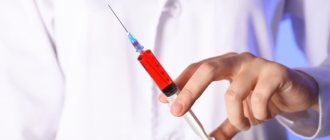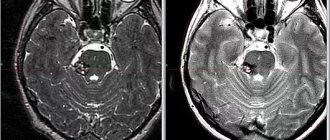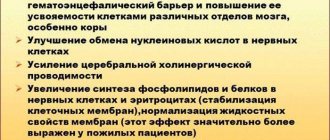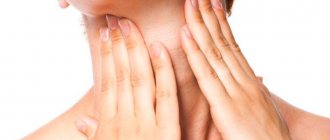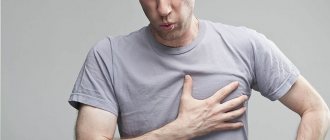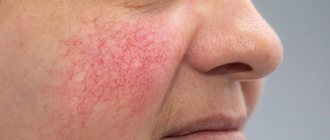The essence of autohemotherapy
Under such a complex name is hidden a very simple procedure. Venous blood is taken from the patient and then injected into the buttock intramuscularly. Sometimes the taken biomaterial is enriched with ozone and homeopathic remedies and only then introduced into the body.
The main goal of autohemotherapy is to activate the body's immune system to combat skin defects and certain diseases.
The doctor draws blood from a vein into a syringe and immediately injects it into the patient’s buttock
How does it work
The action of the procedure is based on the same principle on which homeopathy is built - “like is effectively treated by like.”
Blood for autohemotherapy is taken from a vein. This is the blood that has already given all the beneficial substances to the internal organs and has absorbed toxins and harmful components. This biomaterial is injected into the buttock. The body reacts instantly to the additional amount of toxins. To cleanse itself of harmful components, it forces many systems to work with redoubled force . The immune system is activated, metabolic processes are accelerated, and blood flow is stimulated. Against the background of such processes, the body begins to cleanse itself and fight diseases.
Unfortunately, there is no scientific evidence for this theory to this day. Despite the fact that autohemotherapy was invented by the German surgeon August Bier back in 1905, it still remains poorly understood. Some doctors consider such blood transfusions to be pseudoscientific, while others successfully use them to treat many diseases.
Autohemotherapy - video
Contraindications to the procedure
Despite the positive aspects of autohemotherapy, the blood transfusion procedure has contraindications in which the use of this method of treatment is categorically excluded:
- terminal stage of cancer;
- chronic diseases with severe complications;
- mental health disorders;
- serious disturbance of the rhythm and speed of contraction of the heart muscle;
- condition of acute myocardial infarction;
- high blood sugar;
- endocrine system disorders;
- various blood diseases;
- HIV infection, AIDS.
The presence of contraindications is revealed during a comprehensive examination of the body, based on the patient’s life history and medical history. If the attending physician assumes that autohemotherapy has a risk of causing complications in the patient’s body or will cause more harm than good, then treatment using such a technique is strictly prohibited.
When is autohemotherapy prescribed?
If acne does not respond to conservative treatment, then doctors recommend resorting to a blood transfusion from a vein into the buttock. The procedure works effectively for the following skin defects:
- acne;
- acne;
- purulent acne;
- boils;
- inflammation;
- papillomas
However, acne is not the only pathology for which autohemotherapy is recommended.
If acne does not respond well to medication, your doctor may recommend a blood transfusion.
Indications for blood transfusion may be as follows:
- psoriasis, various dermatitis;
- wounds that do not heal for a long time;
- diseases of the respiratory system and ENT organs (pharyngitis, laryngitis, pneumonia, otitis);
- purulent processes that are difficult to treat with medication;
- allergic diseases (bronchial asthma, hay fever);
- gynecological pathologies (inflammatory, adhesive processes, menopausal syndrome);
- diseases of the urinary system;
- pathologies of the endocrine system;
- VSD (vegetative-vascular dystonia);
- varicose veins;
- early skin aging.
Indications for autohemotherapy:
Due to the fact that autohemotherapy causes persistent activation of rehabilitation and protective mechanisms, intensive healing of wounds and injuries, accelerated recovery from inflammatory processes, it is very popular and is included in treatment regimens for various dermatological and cosmetic problems among all ages and categories. Autohemotherapy gives good results in the treatment of indolent and recurrent diseases, has a positive effect on the body as a whole and on the skin in particular:
- getting rid of purulent and inflammatory processes;
- acceleration of reparative processes;
- improvement of metabolism;
- strengthening the immune system;
- improvement of blood and lymph flow;
- normalization of the endocrine system;
- removal of waste and toxins from the body;
- restoration of performance and vitality.
Contraindications
Autohemotherapy forces one's own immunity to fight diseases. In some diseases and conditions, it is extremely undesirable to interfere with the work of the body's defenses. Thus, blood transfusion is contraindicated if:
- oncology;
- pregnancy;
- epilepsy;
- tuberculosis in active form;
- lactation;
- renal failure;
- cardiovascular pathologies in acute stages;
- menstruation;
- mental illnesses in the acute phase;
- alcohol intoxication;
- elevated temperature.
During pregnancy, autohemotherapy is not carried out, since interfering with the immune system of the expectant mother is strictly prohibited
Blood transfusions are not performed if hemoglobin levels are low. The procedure is prohibited for patients in whose bodies HIV infection, hepatitis B, C or sexually transmitted diseases have been detected.
What does a blood transfusion from a vein into the buttock give?
First of all, autohemotherapy allows you to adjust the patient’s immunity, strengthening the body’s defenses and triggering the necessary mechanisms for recognizing antigens. After a full course of procedures, patients note greater resistance to colds and viral diseases, improved health and a reduced risk of developing fungal and bacterial infections. Those who used transfusion report many times more benefits than harm.
In addition, autohemotherapy can cope with some forms of oncology, teenage acne, diseases of the cardiovascular and nervous system. The main advantage of the procedure is the cessation of the use of a number of drugs such as antibiotics, NSAIDs, steroidal anti-inflammatory drugs and other drugs necessary for the treatment of a whole group of inflammatory diseases.
Often, the use of blood transfusion is harmless and does not cause any discomfort to the patient, bringing only benefits.
Side effects
Blood transfusion is a fairly harmless procedure. Since the body receives its own blood, allergic reactions almost never occur. However, some other side effects may occur.
Autohemotherapy may be accompanied by:
- muscle pain;
- increased temperature;
- slight weakness;
- characteristic “bumps” after injections.
Most often, patients complain about lumps at the injection site. The appearance of such “bumps” is quite justified. Human blood is denser than many drugs . That is why it is absorbed into tissues much more slowly.
After an injection into the buttock, lumps often occur
In extremely rare cases, the patient may experience a negative autoimmune reaction to the procedure. In this case, the person’s health condition sharply deteriorates, and a purulent abscess appears at the site of blood injection. If you experience such symptoms, you should immediately seek help from a doctor.
Benefits of using blood plasma
The use of PRF membranes allows for natural stimulation of the growth of jaw bone cells or periodontal tissues, which significantly accelerates their growth processes. Rehabilitation and engraftment of implants or bone material occurs faster, and the risks of inflammatory processes are significantly reduced.
The use of blood plasma has a positive effect on the following processes:
- acceleration of bone tissue cell growth after implantation,
- absence of allergic reactions that may occur when using artificial materials,
- rapid healing of soft mucous membranes after installation of dental implants or plastic surgery,
- prevention of the risk of peri-implantitis after implant installation,
- reduction of tissue swelling, reduction of pain after any surgical interventions,
- rapid tissue restoration after tooth extraction,
- reduction of inflammation during gum curettage and cleaning of gum pockets.
Expert opinion
Nikolay Vladimirovich Namdakov Maxillofacial surgeon, implantologist, orthopedist Work experience 17+
“The specialists of our clinic have been actively using this technology in their work for many years - they have completed the necessary training and know hematology, understand the mechanisms of blood clotting. Therefore, we do not encounter any difficulties in working with this equipment. Each person has his own characteristics of both the body and the circulatory system, so we use a strictly individual approach even in such a matter as obtaining PRF membranes.”
Blood transfusion techniques
If the patient has no contraindications for autohemotherapy, the doctor prescribes a course of procedures. There are several methods of transfusing blood from a vein into the buttock. The appropriate method of autohemotherapy and the number of recommended procedures are determined by the doctor. In some cases, the transfusion regimen is developed on an individual basis.
So, the most popular and widespread methods of autohemotherapy.
Increasing
The classic method of autohemotherapy is based on a gradual increase in dosage . This scheme allows you to protect the patient from the occurrence of unpleasant side effects in the form of muscle pain, fever, chills.
Increasing autohemotherapy involves a gradual increase in dosages of blood taken from a vein and injected into the buttock
Transfusions are carried out according to the following scheme:
- Day 1 - 2 ml of blood is taken and this amount is immediately injected into the buttock;
- Day 3 - the dose is increased to 4 ml;
- Day 5 - 6 ml of blood is collected and injected;
- Day 7 - the amount of blood increases to 8 ml;
- 9, 11 days - on these days the maximum amount of blood is taken - 10 ml, and injected in full into the buttock;
- Day 13 - dose reduction to 8 ml;
- Day 15 - the amount of blood decreases to 6 ml;
- Day 17 - now 4 ml is administered;
- Day 19 - therapy is completed by administering 2 ml of blood.
There is another type of classical autohemotherapy regimen. It involves carrying out a transfusion every day. Blood dosages are increased daily by 1 ml. This scheme is more aggressive. Therefore, it often provokes side effects.
With ozone
Sometimes doctors recommend autohemotherapy with ozone. This procedure effectively relieves acne, some skin diseases, and helps fight gynecological pathologies . The essence of the procedure is as follows. Blood taken from a vein is enriched with ozone and then injected into the body.
During major autohemotherapy, venous blood enriched with ozone is injected into the vein by drip
There are 2 methods of such autohemotherapy:
- Small. Approximately 10 ml of blood is collected. The enriched composition is injected into the buttock.
- Big. In this case, about 100–150 ml is taken from the patient. After adding ozone, the solution is injected dropwise into a vein.
The biomaterial containing ozone is no longer as dense as pure blood, so it dissolves much faster. Thanks to this, the event is easier to tolerate by the patient and less likely to lead to side effects.
Technique for autohemotherapy with ozone - video
Stepped
With stepwise autohemotherapy, the blood is enriched with specially selected homeopathic drugs. This procedure is in demand in the treatment of acne that is viral in nature. In addition, stepwise autohemotherapy is used to combat chronic eczema, psoriasis, viral infections, arthrosis, and helps treat toxic liver damage.
For the procedure, a small amount of blood is taken - about 0.1–0.2 ml. The biomaterial is mixed with the selected homeopathic medicine. The syringe with the mixture is shaken vigorously and immediately injected into the buttock. Then a small amount of venous blood is collected again. Another homeopathic medicine is added to it. The contents of the syringe are vigorously mixed and reinjected into the buttock. One stepwise autohemotherapy may include 4 stages. Thus, up to 4 homeopathic remedies can be introduced into the body in one session.
This blood transfusion makes it possible to significantly activate the immune system and more actively fight the sources of diseases.
Autohemotherapy helps get rid of acne and promotes healthy body
Is it possible to carry out autohemotherapy at home?
Autohemotherapy should be carried out by an experienced doctor and preferably in a clinical setting. Sometimes patients insist on performing the procedure at home. Doctors do not recommend doing this.
At home, it is quite difficult to create sterile conditions in which the event is held. If this requirement is not met, then there is a high probability of infection entering the body, and sometimes the development of sepsis.
In addition, we should not forget that even to such a simple procedure, each body reacts individually. Therefore, it will be better if the doctor has at hand all the necessary medications that will quickly (if necessary) bring you to your senses.
Rehabilitation after the procedure
The body recovers quickly after autohemotherapy. No special rehabilitation measures are required. However, some recommendations can significantly improve the effectiveness of transfusion and prevent the development of unwanted complications.
After autohemotherapy, it is necessary to choose the right care products and regularly take care of the skin
Doctors advise:
- Elimination of additional load. After autohemotherapy, protective mechanisms begin to actively work in the body. At this time, it is recommended to avoid contact with people who have a cold; you should not expose yourself to sudden temperature changes. Such actions will further increase the load on the immune system. As a result, a respiratory disease may develop and chronic pathology may worsen.
- Choosing the right nutrition. Diet plays a significant role in the treatment of acne. That is why it is almost impossible to get rid of skin defects without following a diet. The diet is based on excluding pickles, smoked meats, sweets, and soda from the menu. In addition, doctors recommend giving up alcohol.
- Proper skin care. This is another important point that can save you from acne or, on the contrary, become a source of skin problems. In order not to make a mistake with the choice of cosmetics, it is recommended to first consult with a cosmetologist. All products should match your skin type and, if possible, solve the main problems. And remember that cosmetic preparations will only be beneficial if they are used regularly.
- Fighting seals. After the first autohemotherapy procedure, doctors advise applying an iodine mesh to the buttock. This will serve as a good prevention for the appearance of cones. A fresh cabbage leaf with honey works well to dissolve lumps.
- Active lifestyle. To help the body quickly defeat harmful components, it is recommended to walk daily in the fresh air, thereby enriching all organs with oxygen. Adequate physical activity is beneficial. But not excessive.
- Maintaining hygiene. This measure will protect against infection entering the body.
Walking in the fresh air is very beneficial for the body.
Pros and cons of the procedure
The opinions of doctors, as well as patients, vary greatly. Some people testify to the high effectiveness of autohemotherapy. Others point to serious shortcomings of the event.
Among the advantages, the following points are usually indicated:
- Efficiency. According to statistics, an improvement in skin condition and a decrease in the number of acne after a blood transfusion is observed in 80–85% of patients.
- Additional treatment. After the procedure, the work of many systems in the body is activated. This allows you to effectively fight not only acne, but also many chronic diseases and inflammatory processes.
- Simplicity. Autohemotherapy does not require special equipment. To perform the procedure, you only need a sterile syringe.
- Harmlessness. The event almost never causes serious side effects.
However, along with its advantages, autohemotherapy has a number of disadvantages. Among them:
- Incomplete knowledge. Doctors do not have sufficient information about the processes that occur in the body. Therefore, they cannot predict in advance how effective the therapy will be.
- The appearance of cones. Such seals cause serious discomfort. Sometimes they even make it difficult for a person to walk and prevent them from sitting normally.
In some cases, autohemotherapy does not get rid of acne. Doctors say that most often, blood transfusions are ineffective if skin defects are caused by digestive or endocrine disorders. With such pathologies, the patient requires drug therapy. And a procedure such as autohemotherapy can only be an additional direction of conservative treatment.
According to statistics, blood transfusion helps eliminate acne in 80–85% of all cases
One very pretty girl, Julia, studied with me at the university. Her pretty face was very spoiled by acne. And as the girl herself complained, not just her face. Huge inflamed pimples covered almost the entire back, shoulders, and chest. In the fight against such defects, Julia tried many different techniques. But there was no positive result. And at that moment, when Yulia was ready to give up, the doctor advised her to take a course of autohemotherapy. At that time, the meaning of such a transfusion was completely unclear to me, but in order to support my classmate, I trudged along with her to the clinic. The procedure took no more than 5 minutes and, according to a friend, was painless. I don’t know how many procedures Yulia underwent, and according to what scheme, but the results of the treatment made me believe in a “miracle”. The girl's skin was significantly cleared of acne, inflammation and redness disappeared. And Julia’s face became very fresh.
Cost of autohemotherapy
The cost of autohemotherapy depends on the region of the event, the status of the medical institution and the type of procedure.
Moscow clinics have the following average prices (price for 1 injection):
- the classic procedure costs 600–1000 rubles;
- the ozone technique will cost 900–1100 rubles;
- stepwise autohemotherapy - from 1300 to 1900 rubles. (the price depends on the homeopathic medicines included in the procedure).
Only a doctor can select a scheme and frequency of procedures after examining the patient. The cost of autohemotherapy also depends on such prescriptions.
